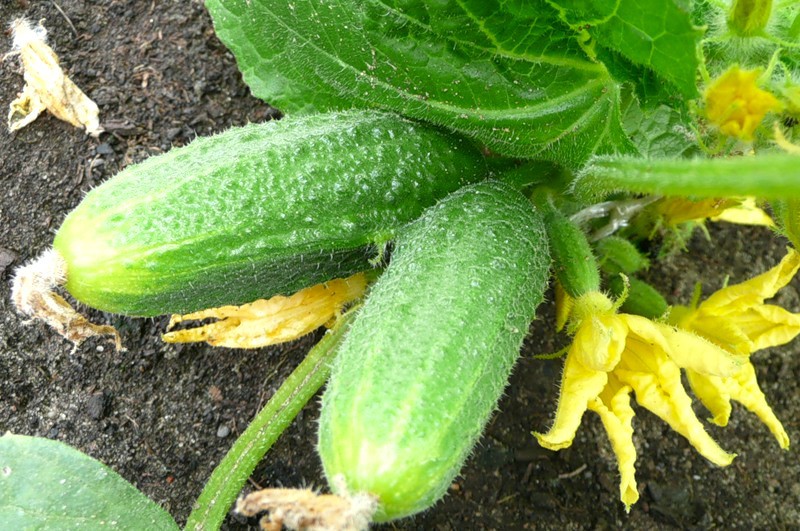 In recent years, the weather in the summer is not always favorable for the cultivation of cucumbers in garden beds. Therefore, the number of vegetable growers who prefer to grow heat-loving cucumbers in greenhouses is increasing. Harvest from greenhouse cucumbers is usually 3-4 times higher than in the garden bed.
In recent years, the weather in the summer is not always favorable for the cultivation of cucumbers in garden beds. Therefore, the number of vegetable growers who prefer to grow heat-loving cucumbers in greenhouses is increasing. Harvest from greenhouse cucumbers is usually 3-4 times higher than in the garden bed.
In this regard, greenhouse cucumbers carry much more nutrients with the crop, compared with cucumbers growing in the open.
Content
- 1 Why nutrition
- 2 Top-up dates. How often to feed
- 3 Root and foliar top dressing
- 4 Mineral fertilizers
- 5 Organic fertilizer
- 6 What to do if you have applied excess fertilizer
- 7 How to understand that fertilizers are not enough
- 8 How to feed, so as not to turn yellow
- 9 What to feed if pale
- 10 What fertilizers to make so plump
- 11 How to determine by appearance what extra nutrition is missing
- 12 What trace elements do plants need?
Why nutrition
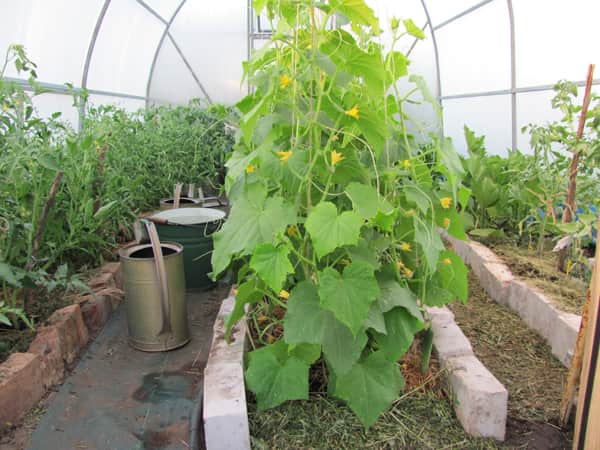 For what reason should cucumbers be fed in protected ground during the growing season of the crop, if during the main digging of the soil, it was well seasoned with organics and mineral tuks?
For what reason should cucumbers be fed in protected ground during the growing season of the crop, if during the main digging of the soil, it was well seasoned with organics and mineral tuks?
The need for top dressing arises from the fact that cucumbers have very weak roots that are not able to absorb food from the soil depths. The rapidly growing vegetative mass of cucumbers already in the first month of life exhausts all food reserves located in the surface soil layer.
In order to form a worthy crop of greenhouses, maintain a high level of plant immunity and increase their resistance to dangerous diseases, it is necessary to introduce mineral fertilizers and organic throughout the entire period of growing cucumbers.
For good development, cucumbers require a fairly high relative humidity and regular feeding. All activities for top dressing and irrigation of plants should be performed in the morning. Then the plants will dry out before evening and will not become infected with fungal diseases. In the absence of intense sunlight, you can not be afraid of burns of the leaves of the culture.
Immediately after placing the plants in a permanent place in the greenhouse, you need to think about carrying out the first feeding. But this does not mean at all that it is not necessary to feed the seedlings of cucumbers with a suck.
To perform feeding and watering, only warm water should be used. Watering with cold water is a direct path to fungal diseases of cucumber plants.
Top-up dates. How often to feed
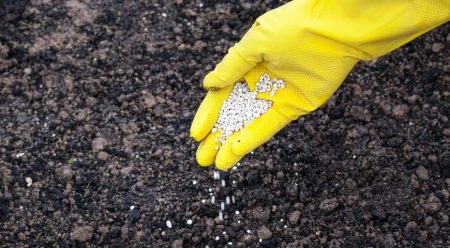 Filling the soil, suggested for cucumbers, with fertilizers should begin in the fall. For the autumn digging of the soil, one bucket of compost or humus should be added per square meter. Given that in greenhouses, as usual, the acidity of the soil solution is above average, simultaneously with the introduction of organic matter, should be for each square. meter add 500 g of lime.
Filling the soil, suggested for cucumbers, with fertilizers should begin in the fall. For the autumn digging of the soil, one bucket of compost or humus should be added per square meter. Given that in greenhouses, as usual, the acidity of the soil solution is above average, simultaneously with the introduction of organic matter, should be for each square. meter add 500 g of lime.
In the spring, the area where the cucumbers will grow, is fertilized with mineral fertilizers 8 days before the seedlings are planted. Contribute to each square. meter needed:
- 30 g of ammonium nitrate;
- 20 g of potassium sulfate;
- 30 g of superphosphate.
After this, the soil is dug up, and then disinfected with a solution of potassium permanganate.
It was established that in order to obtain a worthy crop of greenhouses in the greenhouse, after planting, they need to be fed at least 5 times:
- 1 top dressing is carried out 13 days after planting seedlings with fertilizers containing potassium and nitrogen;
- 2 top dressing is performed when plants enter the flowering phase, using fertilizers containing potassium, nitrogen, magnesium and trace elements;
- 3 top dressing is timed to the beginning of fruiting and carried out by the same means as the second time;
- 4 top dressing is carried out 15-18 days after the third and phosphorus-containing fertilizers are added to the usual composition;
- after another 17 days it is planned 5 top dressing with complex mineral fertilizers.
Feeding seedlings
 A series of dressings should be started when growing cucumber seedlings. Fertilizers are used in the preparation of nutrient soil for seedlings. It should consist of:
A series of dressings should be started when growing cucumber seedlings. Fertilizers are used in the preparation of nutrient soil for seedlings. It should consist of:
- humus (40% by volume);
- turf land (50%);
- sand or sawdust to give friability to the soil (10%).
In addition, some wood ash is added to the composition and then the mixture is shed with a hot solution of potassium permanganate. Wood ash is a source of potassium, and potassium permanganate will become a source of manganese. These nutrients are needed for the normal growth and development of cucumbers.
The first time seedlings of cucumbers are fed in the phase of 1-2 real leaves. At this stage, nitrogen, potash and phosphorus fertilizers must be added to accelerate the growth of stems and leaves, as well as the formation of a strong root system.
After 2 weeks, the seedlings in the nursery are fed repeatedly with the same composition of fertilizers. Having received the next portion of nutrients, seedlings acquire even greater immunity and more easily tolerate stress during subsequent transplantation into the ground to a permanent place.
It is best adapted to a new place for seedlings, whose age is 30 days.
Top dressing after landing
 No matter how carefully we try to transplant seedlings to a new place, nobody succeeds in completely avoiding plant stress. Therefore, after about 10-14 days, after placing the seedlings in a new place, in order to reduce stress and stimulate the growth of the vegetative mass of cucumbers, as well as to form a branched root system, it is necessary to provide seedlings.
No matter how carefully we try to transplant seedlings to a new place, nobody succeeds in completely avoiding plant stress. Therefore, after about 10-14 days, after placing the seedlings in a new place, in order to reduce stress and stimulate the growth of the vegetative mass of cucumbers, as well as to form a branched root system, it is necessary to provide seedlings.
There are many nutritional recipes, but you can focus on this:
- in 10 l of water dilute 20 g of superphosphate;
- mix well until the fertilizer is completely dissolved;
- add there 20 g of potassium sulfate and 15 g of ammonium nitrate;
- mix thoroughly again.
Water the cucumbers with the resulting solution. It should be enough for 12-15 plants.
Strictly observe the concentration of the nutrient solution. Excess fertilizer can lead to burns of the leaves, and if excess nitrogen fertilizers are applied, then the fruits will have an increased content of nitrates - substances harmful to the human body.
Vegetable growers use fertilizers that do not contain nitrogen in nitrate form, such as:
- potassium sulfate;
- crystallin A;
- gumatized fertilizer.
Mullein is considered an excellent nutritional supplement. Introduced into the aisles of cucumbers, it will become not only a source of a number of nutrients, but also, during decomposition, it will emit carbon dioxide, which is necessary for the normal course of photosynthesis.
It is completely unacceptable to lay a mullein in the immediate vicinity of the roots of cucumbers - this is fraught with a burn.
During flowering
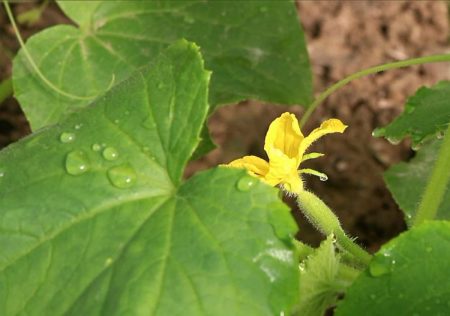 The next feeding of cucumber plantations should be carried out in the phase of mass flowering of the culture. Usually this happens after 16-22 days, after the first feeding of seedlings, planted in a new place. During this period, cucumbers still grow and develop intensively and, therefore, they need nitrogen. But, simultaneously with nitrogen, the formation of flowers and ovaries requires more potassium, and of trace elements - magnesium and boron.
The next feeding of cucumber plantations should be carried out in the phase of mass flowering of the culture. Usually this happens after 16-22 days, after the first feeding of seedlings, planted in a new place. During this period, cucumbers still grow and develop intensively and, therefore, they need nitrogen. But, simultaneously with nitrogen, the formation of flowers and ovaries requires more potassium, and of trace elements - magnesium and boron.
For this feeding, in practice, bird droppings and mullein have proven themselves well. If you intend to feed the cucumbers with bird droppings, then you should do the following preparatory steps:
- dilute chicken droppings with water in a ratio of 1:15;
- take 10 l of this solution and add to it 150 g of wood ash;
- mix thoroughly.
Water the cucumber beds with the resulting solution at the rate of: 1 liter of liquid per 1 plant.
If you are going to use mullein to feed flowering cucumbers, then you can prepare a working solution according to this recipe:
- pour 10 liters of water into a bucket;
- add to it 500 ml of liquid mullein and nitrophoska in the amount of 1 tablespoon;
- mix the composition and add another 150 g of ash, 0.5 g of boric acid and 0.3 g of manganese sulfate;
- mix the solution thoroughly.
Ready solution to water the soil under the cucumbers, pouring 3 liters per square meter. meter.
During fruiting
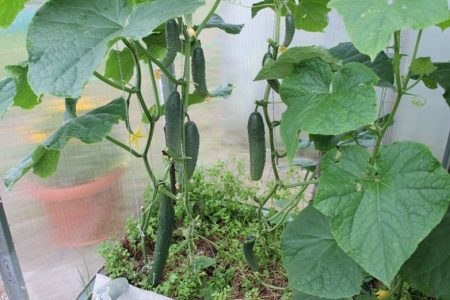 This is one of the most important stages in the process of cultivating cucumbers. Emerging cucumbers require more potash fertilizers, so they should be applied in a timely manner. For top dressing, it is allowed to use the same fertilizer compositions that were used on flowering cucumbers, but you can try new combinations:
This is one of the most important stages in the process of cultivating cucumbers. Emerging cucumbers require more potash fertilizers, so they should be applied in a timely manner. For top dressing, it is allowed to use the same fertilizer compositions that were used on flowering cucumbers, but you can try new combinations:
- dissolve 30 g of potassium nitrate in a bucket of water;
- add there 50 g of urea;
- wood ash in an amount of 500 g;
- mix well.
Fertilize under the root at the rate of 8 liters per m2.
Root and foliar top dressing
During the growing season, cucumbers growing in the greenhouse require regular top dressing. According to the method of feeding, they are divided into:
- root
- foliar.
Top dressing under the root
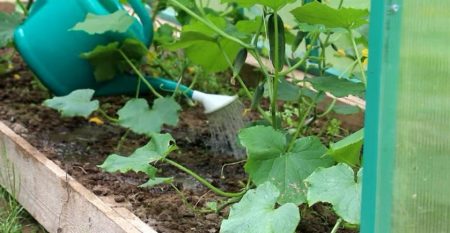 Such dressings can be carried out by applying mineral and organic fertilizers or a combination of these types of fertilizers. In principle, you can do only root dressings, without resorting to spraying plants with fertilizer composition. However, it is better to use both methods of application.
Such dressings can be carried out by applying mineral and organic fertilizers or a combination of these types of fertilizers. In principle, you can do only root dressings, without resorting to spraying plants with fertilizer composition. However, it is better to use both methods of application.
Root top dressing should be carried out after preliminary moistening of the soil. For plant organisms, it is better if top dressing is carried out on a cloudy day.
Planting seedlings in a greenhouse for a permanent place is carried out in phase 4 of these leaves. For growth and development, they need nitrogen, potassium and phosphorus. The content of these elements in the soil is insufficient, and sometimes they may be inaccessible. Therefore, young cucumber plants must be fed.
For feeding, you can use the finished mineral fertilizer complex, containing all the necessary nutrients in a balanced way. It is also allowed to independently prepare a working solution of mineral fertilizers containing these 3 important nutrients.
Fertilizer Recipe:
- take 10 liters of water;
- dissolve in water 20 g of superphosphate, 15 g of ammonium nitrate and 15 g of potassium sulfate;
- mix the composition until the ingredients are completely dissolved.
This prepared solution should be enough to feed 15 young plants.
Cucumbers can get good balanced nutrition from azofoski or nitroammofoski. They have the whole set of macronutrients needed by young cucumbers. The solution is prepared by breeding 1 tbsp. l of substance in 10 l of water.
The work of preparing a nutrient solution from mineral fertilizers must be performed in a shirt with long sleeves and gloves.
It is well known that with the growth and development of greenhouse cucumbers, their need for certain types of fertilizers changes, and the general need for nutrients increases.
Foliar top dressing
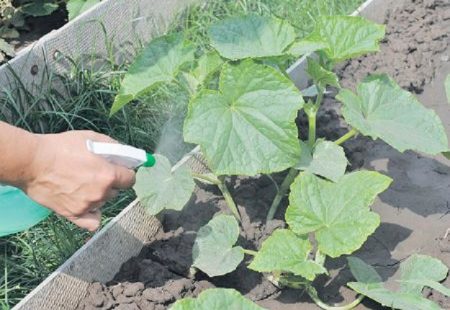 It is also possible to feed cucumbers growing in the greenhouse using the non-root method with ready-made mineral complexes or with personally prepared mixtures of mineral fertilizers. Here, the same types of fertilizers that are used when feeding under the root are suitable. The difference is only in the concentration of the nutrient solution. When spraying on leaves, it is reduced by 2 times to avoid burns to plants.
It is also possible to feed cucumbers growing in the greenhouse using the non-root method with ready-made mineral complexes or with personally prepared mixtures of mineral fertilizers. Here, the same types of fertilizers that are used when feeding under the root are suitable. The difference is only in the concentration of the nutrient solution. When spraying on leaves, it is reduced by 2 times to avoid burns to plants.
Three recipes for foliar feeding:
- dissolve in a bucket of water 10 g of superphosphate, 30 g of potassium nitrate, 1 g of boric acid, 0.4 g of manganese sulfate, 0.1 g of zinc sulfate;
- 50 g of urea per 10 liters of water;
- 1 tsp boric acid, 10 crystals of potassium permanganate dissolved in 1 l of water.
Prepared solutions carry out foliar feeding until the leaves are completely wetted.
Foliar top dressing acts faster than root and should be preferred when cucumbers are grown on relatively cold soil. It is known that plants absorb nutrients worse from cold soil.
Processing on the leaves is carried out with a sprayer and, at the same time, it is necessary to achieve the smallest spray of liquid. The smaller the droplet size, the more efficiently the plant absorbs water with the nutrients dissolved in it.
Mineral fertilizers
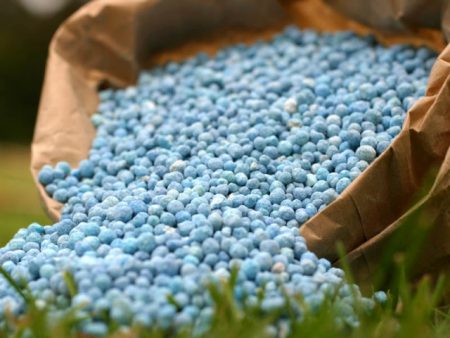 Many gardeners use mineral fertilizers for fertilizing.
Many gardeners use mineral fertilizers for fertilizing.
Such a composition has shown good efficiency in practice:
- put in a bucket of 20 g of superphosphate, 10 g of potassium chloride and 10 g of ammonium nitrate;
- mix the composition.
The prepared solution moisturize the root zone of cucumbers and it should be enough for 10 plants.
To perform the first feeding of cucumbers, after planting in a greenhouse at a permanent place, you can apply the following fertilizer recipes:
- dissolve 1 tbsp in a bucket of water urea, 60 g of superphosphate;
- Sprinkle 5 g of ammophos on the surface and embed it into the soil by loosening;
- take 10 g of ammonium nitrate, superphosphate, potassium salt and dissolve them in 10 l of water.
To perform the second and third cucumber dressing, such recipes are suitable:
- 20 g of potassium nitrate, 30 g of ammonium nitrate, 40 g of superphosphate per 10 l of water;
- Dissolve 20 g of potassium nitrate in 10 l of water.
In the fruiting phase of cucumbers, the following doses of fertilizers are recommended per bucket of water:
- ammonium nitrate - 15-20 g;
- superphosphate - 20 g;
- potassium sulfate - 20 g.
Before applying fertilizer, it is always helpful to pre-wet the area.
Organic fertilizer
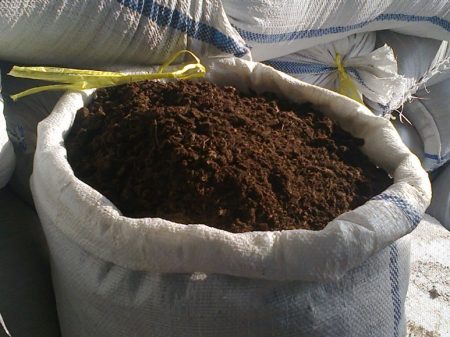 Not all gardeners want to feed cucumbers with mineral fertilizers. Some of them are clear adherents of top dressing with organic and folk remedies.
Not all gardeners want to feed cucumbers with mineral fertilizers. Some of them are clear adherents of top dressing with organic and folk remedies.
Infusion of weeds is quite popular for feeding cucumbers. It is valued for containing nitrogen in an easily digestible form. To prepare it, do the following:
- put chopped weeds in a bucket;
- to fill with water;
- allow the composition to infuse for 4 days, before the appearance of bubbles and an acidic smell;
- dilute the mother liquor with water in a ratio of 1: 5.
Using the prepared working solution, pour cucumbers under the root, pouring 5 liters per square meter. m. Before feeding, it is desirable to moisten the soil.
When the first ovaries of a cucumber appear, organic fertilizer based on mullein and chicken manure, often prepared according to this recipe, is often used:
- place in a bucket 1 liter of liquid mullein and 0.5 kg of bird droppings;
- fill the ingredients with water to the top;
- mix.
With a ready-made solution, pour cucumbers at the root, at the rate of 1 liter per 1 plant.
For the first top dressing of cucumbers, top dressing with an ash solution is also allowed. The recipe is as follows:
- pour 150 g of wood ash into a bucket of water;
- mix the composition.
The solution is used for root dressing, pouring 1 liter of liquid under each root.
Here is another popular recipe for cooking for cucumbers:
- dilute in a bucket of water 500 ml of mullein and add 1 tbsp. l nitrofoski;
- mix the composition thoroughly;
- add another 50 g of potassium sulfate, 0.5 g of boric acid and 0.3 g of manganese sulfate;
- mix the composition until all ingredients are completely dissolved.
Ready solution pour cucumbers at the root, pouring 3 liters per square. m. The greatest effect of such top dressing is observed during flowering and fruiting of the culture.
For cucumber plants, feeding with a solution of wood ash (100 g / 10 l of water) is useful. Cucumbers are fertilized with this solution in any period of growth and development.
What to do if you have applied excess fertilizer
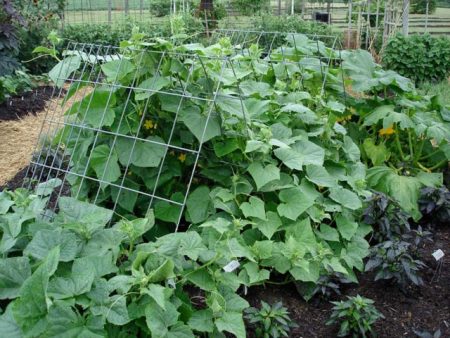 Cucumbers in the garden are better not to over feed than overfeed. Because in the second case, undesirable phenomena can occur, such as changes in the color of leaves, growth retardation, overgrowth of shoots or burns on leaf plates. How will overfed cucumbers look like this or that fertilizer:
Cucumbers in the garden are better not to over feed than overfeed. Because in the second case, undesirable phenomena can occur, such as changes in the color of leaves, growth retardation, overgrowth of shoots or burns on leaf plates. How will overfed cucumbers look like this or that fertilizer:
- If the plants are overfed with nitrogen, then the formation of ovaries slows down on cucumbers. The lashes become too thick, and the leaves become denser and intensely green.
- With an excess of phosphorus fertilizers, the leaf plates are covered with yellowness, necrotic spots that increase in size may appear on them. If you do not take appropriate measures, the leaves begin to fall off.
- If too much calcium is added to the soil, this can also be judged by the leaves. They have inter-vein chlorosis.
- Cucumber plants overfed with potassium immediately begin to slow down their growth.
If an error still occurred, and you exceeded the dose of fertilizers, this will certainly affect the condition of the plants. Normalize the situation can abundant watering of plants at the rate of 15 liters per square. m. Thanks to this technique, excessive amounts of fertilizers are washed out from the upper soil layers to deeper layers, inaccessible to cucumber roots. Flushing the soil with an excess of fertilizer in the soil always gives a positive result.
How to understand that fertilizers are not enough
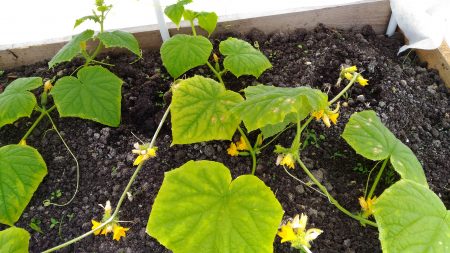 Deficiency of nutrients always affects the appearance of plants, their leaves and fruits. Gardeners with experience easily determine the shortage of cucumbers of a particular nutrient in a visual way.
Deficiency of nutrients always affects the appearance of plants, their leaves and fruits. Gardeners with experience easily determine the shortage of cucumbers of a particular nutrient in a visual way.
The problem is initially indicated by the color change of the leaf blades. If you miss this moment and do not make up for the deficit, then it will be impossible to achieve beautiful marketable fruits. In the future, often, deformation and shredding of leaves, thinning of the stems, stunting of shoots and curvature of the fruits occur. For the deficit of each important element of nutrition these or those signs are characteristic.
In addition to the main nutrients, cucumbers may lack trace elements, as well as oxygen and moisture in the soil. With a lack of nutrition, cucumbers are affected by fungal diseases, grow slowly, and their fruits lose their taste. The sooner a problem is identified and appropriate measures are taken, the better for the crop of cucumbers and its quality.
Keep track of soil moisture throughout the growing season of cucumbers. The lack of water during seedling cultivation is subsequently not compensated in any way, unlike nutrients. Cucumbers will have a bitter taste until the end of the season.
How to feed, so as not to turn yellow
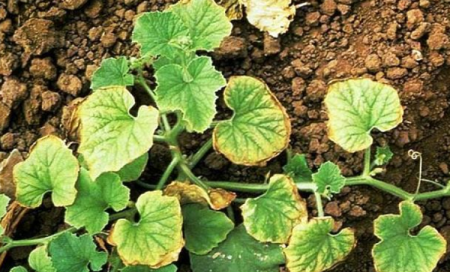 Sometimes, even when fertilizing, gardeners are faced with the phenomenon that the leaves of cucumbers become yellow in color. This can occur with a normal microclimate in the greenhouse and in the absence of pests and diseases, the activity of which can also cause yellow leaves.
Sometimes, even when fertilizing, gardeners are faced with the phenomenon that the leaves of cucumbers become yellow in color. This can occur with a normal microclimate in the greenhouse and in the absence of pests and diseases, the activity of which can also cause yellow leaves.
If you notice on your plantation that the cucumber plants are beginning to turn yellow, try using this foliar top dressing:
- in a ten-liter bucket place a loaf of bread for the night;
- mash bread in the morning and add a bottle of iodine to the bucket;
- dilute 1 liter of the resulting masterbatch in 10 liters of water.
After filtering, apply the solution for spraying the leaves.
In addition, gardeners make a nutrient solution for foliar feeding of nettles according to the following recipe:
- to prepare young nettle free from seeds;
- put it in a bucket and fill it with water;
- composition needs to be insisted within 22 hours.
To prepare a working solution, dilute 1 l of the mother liquor in 10 l of water and start spraying.
What to feed if pale
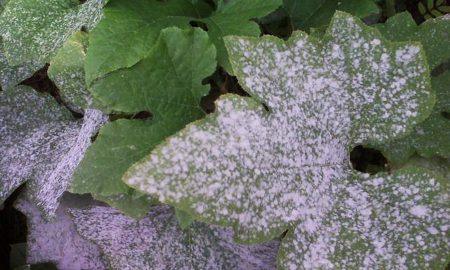 Blanching of leaves in a cucumber in a greenhouse is usually associated with a deficiency of nitrogen or iron in the soil, as well as with the activity of pathogens.To solve the problem, just use one of the following recipes:
Blanching of leaves in a cucumber in a greenhouse is usually associated with a deficiency of nitrogen or iron in the soil, as well as with the activity of pathogens.To solve the problem, just use one of the following recipes:
- Dilute in a bucket of water 1 liter of liquid mullein. Give a little insist, mix the composition. Water the cucumbers with this solution under the root, based on the calculation: 1 liter for each plant.
- Collect weeds in the garden and chop them. In this form, put them in a bucket and pour water. Allow the composition to brew for 14 hours. Before use, dilute the solution in water in a ratio of 1: 5 and proceed to spraying.
- Place two tablespoons of urea in a bucket of water and stir until the fertilizer is completely dissolved. Using the prepared working solution, spray the plants along the leaves.
What fertilizers to make so plump
Gardeners during feeding of cucumber plants, rely on folk remedies, which are always at hand. With their help, they quickly return a favorable appearance to plants and prompt them to abundant fruiting.
More often than usual for cucumber dressings, so that they are plump, apply:
- ash left over from burning wood;
- nitroammophosco;
- infusion of onion peel;
- chicken droppings;
- yeast;
- ready-made fertilizer complexes containing the entire set of essential nutrients.
Nitroammophos dressing
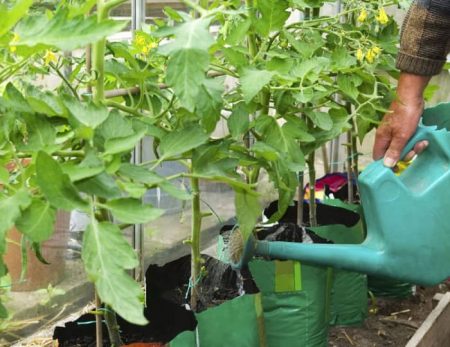 As you know, nitroammophosk contains three main nutrients in the ratio necessary for plants: nitrogen, potassium and phosphorus.
As you know, nitroammophosk contains three main nutrients in the ratio necessary for plants: nitrogen, potassium and phosphorus.
The main advantage of nitroammophoski is its versatility. It is used on all types of soils, however, the greatest effect is obtained when using this chemical on moistened gray-earth and chernozem soils.
It is noticed that after applying nitroammophoski on cucumbers, the number of ovaries and the duration of fruiting increase. Feeding cucumbers with nitroammophos is carried out in two ways:
- embedding a chemical in the soil before planting cucumber seedlings;
- watering under the root before ovaries.
Prior to planting cucumbers in a permanent place, 30 g of nitroammophos are added to each m2 of land. And for the abundant formation of ovaries make a working solution, including 1 tbsp. l fertilizers and 5 liters of water. The flow rate of the working fluid is 500 ml per bush.
Feeding with ash
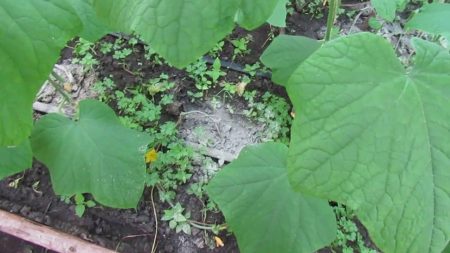 To perform this top dressing, you must first prepare a working solution, thus:
To perform this top dressing, you must first prepare a working solution, thus:
- put in a bucket 250 g of ash;
- pour it with warm water;
- mix the composition.
The resulting liquid solution to water the plants, pouring 1 liter under each bush.
Yeast
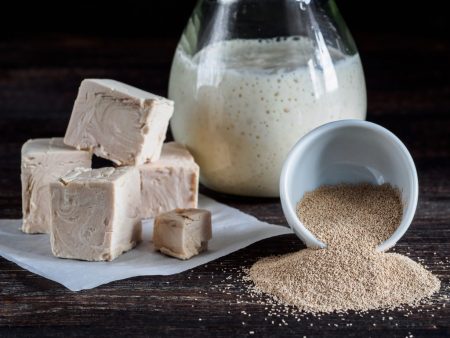 The following macro- and microelements were found in yeast: nitrogen, potassium, phosphorus, iron, manganese, and others. To prepare the working solution, you need to do the following:
The following macro- and microelements were found in yeast: nitrogen, potassium, phosphorus, iron, manganese, and others. To prepare the working solution, you need to do the following:
- take a bucket of water;
- dilute a pack of yeast in it;
- insist 22 hours.
Water the cucumbers with a liquid solution, pouring 1 liter under each spine.
Chicken droppings
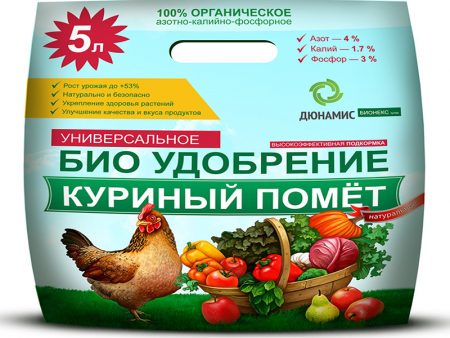 To perform top dressing, fresh bird droppings are used, as well as rotted. The overripe litter should be diluted with water in a ratio of 1:10 and poured 0.7-0.8 l of liquid under each bush. And to apply fresh chicken droppings, you need to dilute it in water in a proportion of 1:20 and spill this solution of cucumber aisle. Do not forget, before feeding, moisten the beds well with water to avoid root burns.
To perform top dressing, fresh bird droppings are used, as well as rotted. The overripe litter should be diluted with water in a ratio of 1:10 and poured 0.7-0.8 l of liquid under each bush. And to apply fresh chicken droppings, you need to dilute it in water in a proportion of 1:20 and spill this solution of cucumber aisle. Do not forget, before feeding, moisten the beds well with water to avoid root burns.
Onion peel
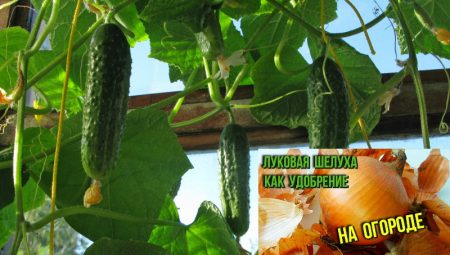 Onion husk is an unnecessary waste, but it turns out that you can fertilize cucumbers. The recipe is prepared as follows:
Onion husk is an unnecessary waste, but it turns out that you can fertilize cucumbers. The recipe is prepared as follows:
- put in a bucket of water 200 g of onion husk;
- pour the husk with water;
- put a bucket on gas and warm to a boil;
- allow the composition to cool to room temperature.
Pour cucumbers with this solution at the rate of: 1 liter per bush.
How to determine by appearance what extra nutrition is missing
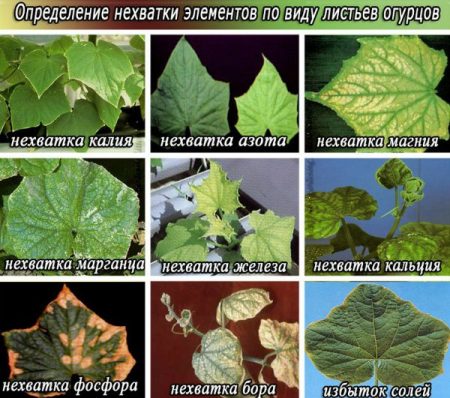 Applying the so-called leaf diagnostics, it is possible to determine by the color and shape of the leaves which nutrients are lacking in greenhouse cucumbers. If the cucumbers look healthy, then it makes no sense to rush with dressings.
Applying the so-called leaf diagnostics, it is possible to determine by the color and shape of the leaves which nutrients are lacking in greenhouse cucumbers. If the cucumbers look healthy, then it makes no sense to rush with dressings.
But, when you notice that the leaves suddenly begin to change their color or shape, cucumber lashes inhibit growth, the plant ceases to bloom - you need to urgently understand the causes of these undesirable phenomena and promptly introduce the missing fertilizers. As in practice, a deficiency of the basic nutrition elements of cucumber plants is manifested and what should be done to solve the problem:
- Lack of nitrogen. Lacking nitrogen, the plants stop the growth of young shoots, the leaves become smaller and paler. Subsequently, the leaf plates become yellow in color and dry out. The flowering of cucumber plants becomes rare, the ovaries become smaller and the greenery grow poorly. It will be possible to quickly solve the problem if you feed cucumbers under the root of slurry or ammonium nitrate. I want to add in the amount of 1 kg, and saltpeter is 30 g per 1 m2 of the plot area. It is also possible to perform foliar feeding with urea, dissolving 30 g of the drug in 10 l of water.
- Phosphorus deficiency. Its symptoms first appear on old leaves. They take on a blue or red hue. Deficiency of this element is most often observed in acidic soils. To make up for phosphorus deficiency, do the following:
- take a bucket of water;
- put there 50 g of superphosphate;
- mix thoroughly until the granules are completely dissolved;
- filter the solution.
Spray the cucumber plants with the prepared solution. After 15 days, repeat plant nutrition with mineral complex fertilizers, based on: 1 tbsp. liters per 10 liters of water.
- Potassium deficiency. When cucumbers lack potassium, rusty spots form on their leaves, most often along the edges of leaf plates. The leaves themselves become corrugated. Cucumber shoots become thinner and hardly grow. To solve the problem, cucumber plants are fed with ash or a solution of potassium chloride.
- Magnesium deficiency. This element is the main one in chlorophyll molecules and photosynthesis is impossible without it. Magnesium starvation causes a slowdown in the movement of photosynthesis products to different parts of the plant. In this case, the growth of cucumbers is inhibited, the roots stop developing and cannot adequately absorb water and the nutrients dissolved in it. The leaves are wrinkled and yellow spots appear on them. Only streaks of green remain on the leaf plates. You can solve the problem by adding magnesium sulfate or magnesium nitrate.
- Sulfur deficiency. Causes a general slowdown in plant growth. The stems do not thicken and remain thin and brittle. The leaves turn whitish, their veins turn pale. If a deficiency of this element is detected, it is necessary to feed the cucumbers with calcium sulfate or magnesium sulfate.
- Calcium deficiency. In this case, the leaves are deformed, they curl and become lethargic. The immunity of plants is reduced, they can be affected by rot. Roots, fruits and stems of plants rot. With a lack of this element, a dry brownish border appears at the ends of the sheet. The timely introduction of calcium nitrate, when the first symptoms appear, solves this problem.
What trace elements do plants need?
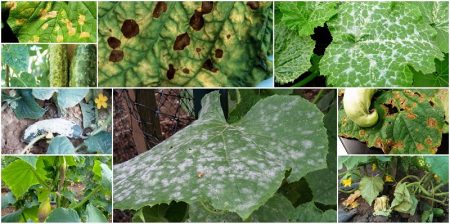 The nutrition of cucumbers must certainly include the whole set of necessary macro- and microelements. Macronutrients include nitrogen, phosphorus, sulfur, magnesium, calcium and potassium, and they are called so, because plants are required in relatively large quantities.
The nutrition of cucumbers must certainly include the whole set of necessary macro- and microelements. Macronutrients include nitrogen, phosphorus, sulfur, magnesium, calcium and potassium, and they are called so, because plants are required in relatively large quantities.
Along with these elements, there are a number of others that are also very important for nutrition, but are absorbed by plants in small quantities. Here they are, just called trace elements. It is possible to fill in the missing quantity of microelements due to top dressing with organic and complex fertilizers.
When planning fertilizing, one must take into account the general condition of plants. The deficit of individual elements is determined visually by the color of the leaves, the shape of inflorescences and fruits.
In order to prevent a deficiency of individual trace elements, it is necessary to introduce a calculated dose of complex fertilizers before planting cucumbers in a permanent place.
Usually, a deficiency of one or another element becomes apparent when external changes manifest. Knowing these signs can help determine what the cucumber plants lack. What signs indicate a lack of a microelement:
- Copper shortage. Petals of flowers showered ahead of time. Cucumber shoots weaken and fade. Leaves turn pale.
- Boron deficiency. The fall of inflorescences. Violation of the shape of the fruit. The appearance of yellow stripes on leaf blades and fruits.
- Manganese deficiency. This element is responsible for the production of chlorophyll and oxidation processes. With manganese starvation, dark green spots appear on the leaves, and the leaf plates themselves lose their original color.
- Iron deficiency. In this embodiment, young leaves lose their ability to photosynthesize. The upper leaves of the plants begin to turn yellow, and the rest of the leaf plates lighten, starting from the veins.
- Zinc deficiency. In this case, the death of individual sections of leaves. Lead or brown spots appear on the leaf plates, the tissue dies, and the litain veins turn black.
The lack of each of these trace elements leads to a decrease in productivity and deterioration in the quality of the fruit. Through foliar top dressing, plants can be quickly helped.
Each grower must decide for himself which feeding option to put into practice. You can use only mineral fertilizers for this or stay on organic. And also, probably, it will be better to combine both of these types of fertilizers. The main thing is to fertilize at the moment when they are needed and never exceed the concentration of the nutrient solution. If you follow these recommendations, then your cucumber plants will surely please you with a worthy crop of delicious greenery.




 Armenian cucumber with melon flavor: description and characteristics, reviews
Armenian cucumber with melon flavor: description and characteristics, reviews Do-it-yourself vertical beds for cucumbers: schemes, photos
Do-it-yourself vertical beds for cucumbers: schemes, photos Hollow cucumbers: reasons for the appearance of hollow, what to do
Hollow cucumbers: reasons for the appearance of hollow, what to do Which manure is best for cucumbers: application, how to breed
Which manure is best for cucumbers: application, how to breed